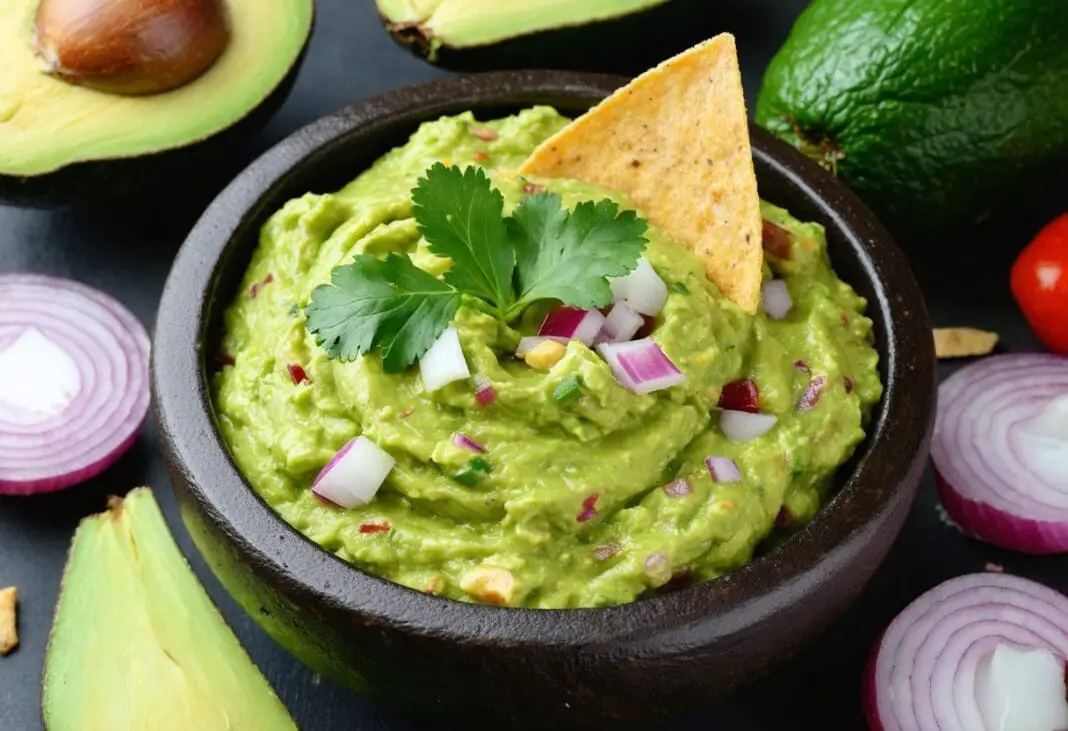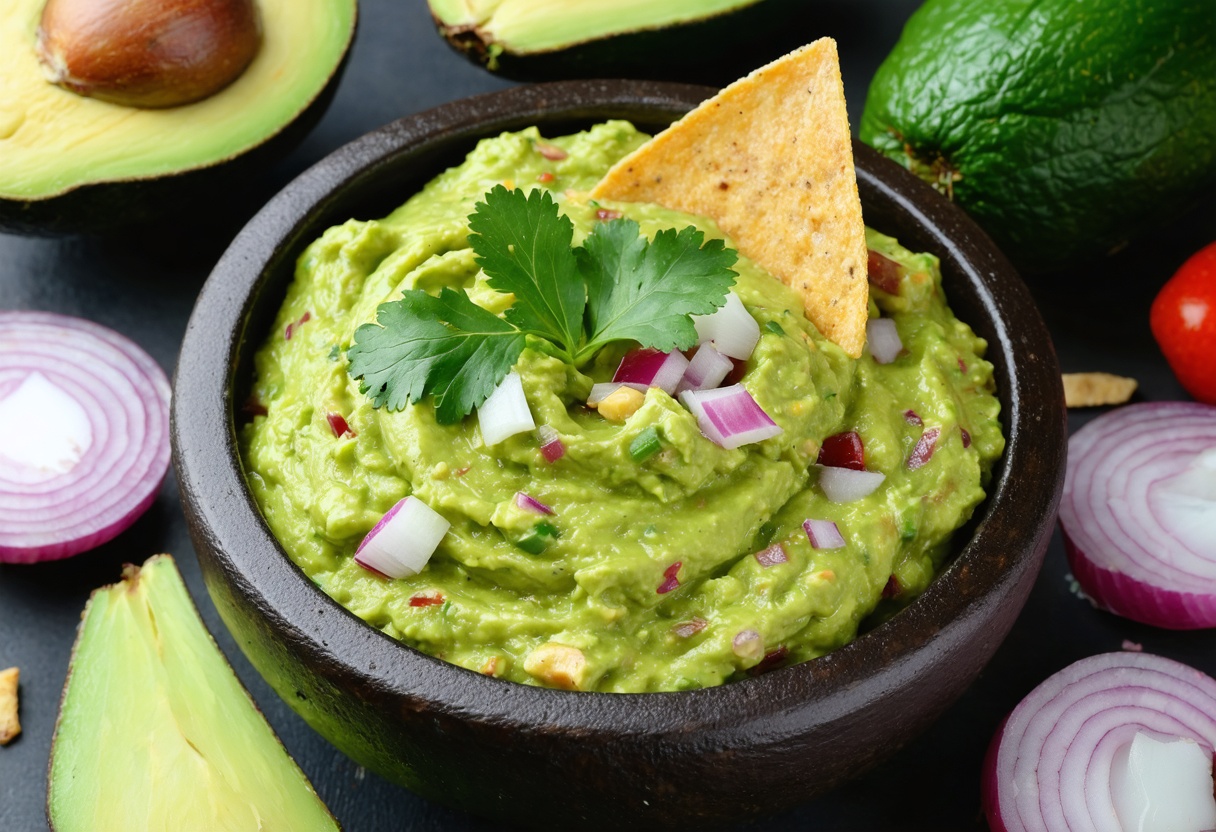Most people think making restaurant-quality guacamole at home is impossible, but there’s actually one game-changing trick that professional chefs use. The secret isn’t about expensive ingredients or fancy equipment – it’s about how you handle the aromatics before mixing everything together. This simple technique transforms basic avocados into the creamy, perfectly seasoned dip that rivals any high-end restaurant.
Smashing aromatics releases maximum flavor
The biggest mistake home cooks make is simply stirring chopped onions, jalapeños, and garlic directly into mashed avocado. Professional kitchens know better. They crush these aromatics first to break down the cell walls and release natural juices and oils that would otherwise stay trapped inside. This technique creates a flavor foundation that permeates every bite of guacamole.
Restaurant chefs traditionally use a molcajete, a Mexican stone mortar and pestle, to accomplish this. The rough surface grinds and crushes ingredients perfectly. But home cooks can achieve the same results using a zip-top bag and rolling pin. Simply place diced red onion, jalapeño, and garlic in the bag, press out air, seal tightly, then crush with the rolling pin until you see juices forming.
Perfect avocado selection makes all the difference
Even with perfect technique, terrible avocados ruin everything. The ideal avocado should feel firm but yield slightly to gentle pressure. Look for Hass avocados with the small stem still attached – if it’s missing, the fruit likely has brown spots inside. The skin should be dark green to almost black, with a slight shine rather than dull matte finish.
Here’s a pro tip: remove the small stem and peek underneath. Bright green flesh means perfect ripeness, while brown indicates overripe fruit. Buy firm avocados several days ahead and let them ripen on the counter. Once perfect, store them in the refrigerator to maintain quality for up to five days before they become too soft.
Two forks create ideal texture
Many people grab a single fork or spoon to mash avocados, but restaurants use two forks for superior control. This method creates the perfect balance between chunky pieces and creamy paste. Start by scoring the avocado flesh while still in the skin, then scoop everything into a large bowl. Use both forks simultaneously to break down the fruit.
The two-fork technique lets you stop mashing at exactly the right moment. Professional kitchens know that slightly under-mashing initially works better because you’ll continue breaking down avocado while folding in other ingredients. This prevents the mushy, baby-food texture that ruins so many homemade batches. Stop when you still see distinct avocado chunks mixed with creamy portions.
Roma tomatoes prevent watery disasters
Regular tomatoes contain too much water and too many seeds, turning guacamole into soup within minutes. Roma tomatoes solve this problem with their meaty flesh and fewer seed chambers. Their firmer structure holds up better when mixed with other ingredients, maintaining distinct pieces instead of dissolving into liquid. Always remove seeds before dicing to minimize moisture.
Some restaurants skip tomatoes entirely, but authentic Mexican preparations often include them for color, texture, and subtle umami depth. Dice Roma tomatoes into small, uniform pieces roughly the same size as your onion and jalapeño pieces. This creates visual harmony and ensures every bite contains a balanced mix of ingredients rather than random large chunks.
Fresh lime juice prevents browning
Bottled lime juice produces flat, artificial-tasting guacamole that browns within hours. Fresh lime juice provides bright acidity that cuts through rich avocado while creating a natural barrier against oxidation. Always use more lime than seems necessary – avocados need substantial acid to balance their fatty richness and enhance other ingredients.
Mexican limes work best, but regular limes suffice if unavailable. Roll the lime on a hard surface while pressing down before cutting to break internal membranes and release maximum juice. Professional chefs squeeze the spent lime halves around the bowl’s rim after mixing to pick up any remaining guacamole and add extra citrus oils to the final product.
Red onions provide sweetness without bite
White onions overpower delicate avocado with sharp, sulfurous heat that lingers unpleasantly. Red onions offer natural sweetness that complements rather than competes with other ingredients. Their milder nature means you can use enough to provide crunch and depth without creating an onion-forward dip that burns the palate.
Dice red onions as finely as possible – large pieces create unpleasant surprises that dominate individual bites. Restaurants often soak diced red onions in cold water for ten minutes before using to remove excess sharpness, though this isn’t necessary with quality onions. The crushing technique mellows harsh onion compounds while releasing sweet juices that enhance overall harmony.
Salt timing affects final texture
Adding salt too early draws moisture from vegetables, creating excess liquid that thins the guacamole. Adding it too late means uneven distribution and bland pockets throughout the dip. The optimal timing involves adding salt during the aromatics-crushing phase, then adjusting seasoning after everything combines. This two-stage approach ensures proper seasoning without textural problems.
Use kosher salt rather than table salt for better control and cleaner taste. Restaurant kitchens typically use more salt than home cooks expect – avocados need generous seasoning to reach their full potential. Start with recommended amounts, then taste and adjust. Properly salted guacamole should taste bright and vibrant, not bland or one-dimensional like many homemade versions.
Tajín adds restaurant-level complexity
This Mexican chile-lime seasoning appears in many high-end restaurant guacamoles for good reason. Tajín combines chili powder, lime, and salt with citric acid that naturally preserves green color while adding layers of heat and tang. The citric acid acts as a natural preservative, keeping guacamole fresher longer than versions made with only lime juice.
Start with small amounts since Tajín contains salt – too much creates an overly spicy, overseasoned mess. Professional chefs often dust finished guacamole with extra Tajín as garnish, creating visual appeal and extra flavor bursts. If Tajín isn’t available, substitute with a mixture of chili powder, lime zest, and a pinch of cayenne, though the preservative benefits disappear.
Storage techniques maintain freshness
The plastic wrap trick works temporarily, but restaurants use better methods for longer storage. Press guacamole firmly into an airtight container, eliminating air pockets. Add about half an inch of cold water on top, creating a barrier against oxygen. When ready to serve, pour off the water and stir briefly – the guacamole stays perfectly green for up to three days.
Never believe the myth about leaving avocado pits in guacamole to prevent browning. This technique only protects the tiny area directly under the pit while the rest browns normally. The water method provides complete coverage and actually works. For immediate serving, extra lime juice drizzled on top creates a temporary barrier against oxidation during parties or gatherings.
This restaurant-quality guacamole transforms ordinary ingredients into something extraordinary through proper technique. The aromatics-crushing method alone elevates homemade dip to professional levels, while attention to ingredient quality and timing ensures consistent results every time. Master these techniques once, and you’ll never buy mediocre store-bought guacamole again.
Restaurant-Quality Guacamole with Smashed Aromatics
Course: Appetizer6
servings15
minutes185
kcalThis restaurant-inspired guacamole uses a secret technique of smashing aromatics to release maximum flavor, creating the perfect creamy yet chunky dip.
Ingredients
3 large ripe Hass avocados
1/4 medium red onion, finely diced
2 jalapeño peppers, finely diced (seeds removed for mild heat)
2 cloves garlic, roughly chopped
1 large lime, juiced (about 3 tablespoons)
1/3 cup finely chopped fresh cilantro
1 teaspoon kosher salt
1/2 teaspoon garlic powder
1/2 teaspoon Tajín chile-lime seasoning
Directions
- Add the diced red onion, jalapeño peppers, and garlic to a large zip-top bag. Season with a pinch of kosher salt. Press out as much air as possible and seal the bag tightly to prevent bursting.
- Using a rolling pin or heavy-bottomed pan, carefully smash the sealed bag to crush the aromatics and release their natural juices. Continue until the vegetables are softened and you can see liquid forming, but don’t crush them into a paste.
- Cut the avocados in half and remove the pits. Score the flesh in a 1/2-inch grid pattern while still in the skin, then use a spoon to scoop all the flesh into a large mixing bowl.
- Using two forks simultaneously, partially mash the avocados until you achieve a chunky-creamy texture with some distinct pieces remaining. Stop slightly before reaching your desired consistency as you’ll continue mashing while mixing.
- Add the smashed aromatics from the bag along with all their juices to the mashed avocados. Include the lime juice, chopped cilantro, remaining kosher salt, garlic powder, and Tajín seasoning.
- Use the two forks to gently fold all ingredients together, continuing to mash slightly until everything is well incorporated and you reach your preferred texture. The guacamole should be creamy with visible chunks.
- Taste and adjust seasoning as needed, adding more salt, lime juice, or Tajín according to your preference. Remember that the amount needed varies based on avocado size and ripeness.
- Transfer to a serving bowl and garnish with extra cilantro and a light dusting of Tajín if desired. Serve immediately with tortilla chips or use as a condiment for tacos, burgers, or other dishes.
Notes
- For longer storage, press guacamole firmly into an airtight container and add 1/2 inch of cold water on top. This prevents browning for up to 3 days in the refrigerator.
- If you don’t have Tajín, substitute with a mixture of chili powder, lime zest, and a pinch of cayenne pepper.
- Leave jalapeño seeds in for extra heat, or use serrano peppers for even more spice.
- Roma tomatoes can be added if desired – dice 1/2 tomato and include with the smashed aromatics.
Frequently Asked Questions
Q: Can I make guacamole ahead of time without it turning brown?
A: Yes, press the guacamole firmly into an airtight container and add about half an inch of cold water on top. This creates a barrier against oxygen and keeps it green for up to three days. Just pour off the water and stir before serving.
Q: What if I don’t have a rolling pin to crush the aromatics?
A: Use any heavy object like a meat mallet, heavy-bottomed pan, or even a wine bottle. You can also use a mortar and pestle if you have one. The goal is to break down the vegetables enough to release their juices.
Q: How do I know if my avocados are perfectly ripe?
A: Gently squeeze the avocado – it should yield slightly to pressure but not feel mushy. Check under the small stem; if it’s bright green underneath, the avocado is perfect. Brown means overripe, while the stem won’t budge on underripe fruit.
Q: Can I substitute bottled lime juice for fresh lime juice?
A: Fresh lime juice is strongly recommended because bottled versions taste flat and artificial. Fresh lime provides the bright acidity needed to balance the rich avocados and helps prevent browning more effectively than processed juice.


